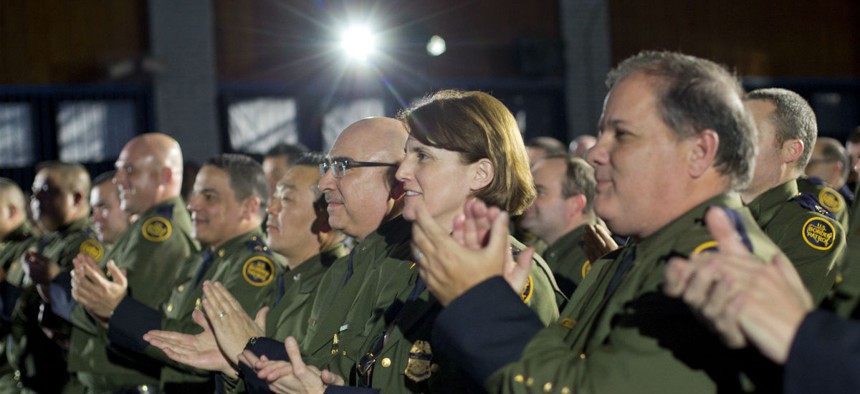
Border Patrol Officers applaud as President Donald Trump is introduced before speaking at the Homeland Security Department Jan. 25. AP Photo/Pablo Martinez Monsivais
Trump Fans and Critics Alike Question the Proposed Hiring Surge at Homeland Security
Senators and unions cast doubt on the plan’s feasibility and necessity.
Lawmakers and employee groups at a Senate hearing on Wednesday cast doubt on President Trump’s planned hiring surge at the Homeland Security Department, saying that a better way to improve border security and immigration enforcement would be to boost sinking morale and rein in a bloated management workforce.
Immigration and Customs Enforcement and Customs and Border Protection are currently sorting out their hiring plans to bring on an additional 15,500 employees at Trump’s direction, but members of the Senate Homeland Security and Governmental Affairs Committee called that proposal politically motivated and unsound policy. Even the unions representing the agencies’ workers said it would be nearly impossible to implement the proposal without first tackling other issues, although they applauded its intent.
Chris Crane, president of the National ICE Council, complained the agency’s agents on the ground are “tripping over managers out in the field.” He said agency leadership created an “old boys club” that consistently deferred blame to the rank and file. Brandon Judd, president of the National Border Patrol Council, accused managers of “kingdom building” by expanding their responsibilities so they would receive promotions. He noted most of BP’s workforce on a given day is in an office rather than out in the field.
Sen. Claire McCaskill, D-Mo., the committee’s ranking member, agreed the agencies were “too management heavy,” while Sen. Ron Johnson, R-Wis., the committee’s chairman, said the complaints were “defining bureaucracy.” Johnson said his committee would work with the union representatives to identify “crazy and insane” practices and highlight them for DHS. The department, he said, already has the capacity to address the issues without additional legislation.
“This isn’t rocket science,” he said. “This isn’t hard, and we're going to get this done.”
While Judd said the proposed hiring surge is “welcome news,” he expressed concern about its feasibility. To keep up with attrition and fill current vacancies, he explained, adding 5,000 new agents would require the Border Patrol to hire more than 2,700 agents every year for the next five years. That's a steep goal for an agency that takes an average of 160 days to move employees through the application process.
“Last year we hired, trained and deployed 485 new agents so you see the cause for my concern this morning,” Judd said. He said the Border Patrol should be realistic. “It is one thing to mandate the hiring of Border Patrol agents. It is another thing to actually do it.”
To fully address the problems with hiring and retention, Judd said the agency must solve outstanding issues regarding pay parity with ICE, morale and polygraph administration.
Customs and Border Protection officials conceded last week that just 25 percent of applicants pass their polygraph exams and said they are looking for ways to hasten the process. Tony Reardon, president of the National Treasury Employees Unions, which represents CBP’s field operations employees, said applicants sometimes endure eight hours of interviews during their polygraph tests. Reardon also echoed concern from lawmakers that Trump’s massive hiring surge would not address staffing shortfalls at ports of entry.
In addition to questioning the feasibility of the plan, lawmakers cast doubt on the need for the surge. McCaskill asked how the Trump administration came up with the hiring targets for ICE and CBP and what analysis was conducted. In her visits to the border, she said, agents expressed a need for better technology and more roads rather than a border wall or more staffing. The senator released a fact sheet ahead of the hearing highlighting that more personnel does not equal more security; since 2000, the document noted, Border Patrol has increased its agents 115 percent and apprehended 75 percent fewer people.
“It doesn’t appear to me this is a well thought-out plan; it appears to me this is political and not solid policy,” McCaskill said. “I want to make sure we’re not engaging in campaign promises instead of policy that will actually secure the border.”
Johnson said he wanted to “find what works” and called for a “top-to-bottom review to figure out how to staff these agencies.”
“That’s the purpose of this hearing,” Johnson said, “to scrutinize these proposals and so we can work with the administration to actually secure the border and enforce border laws.”
Crane expressed the most enthusiasm for the new administration’s proposals, saying for the first time he was able to commend a sitting president and DHS secretary. He made appearances with Trump on the campaign trail last year, and both he and Judd’s union endorsed Trump’s candidacy.
Crane said ICE desperately needed the influx of personnel, but he held “little faith” in the agency’s leaders to “do it properly.” Instead of “thinking outside the box” to bring on new employees, he said, leadership is employing “no innovation, no changes, [just] business as usual.” Even if ICE is able to staff up to Trump’s liking, Crane cautioned it would not solve the agency’s morale issues. ICE maintains a “toxic and failed management culture,” a “screw up to move up” promotion policy and constant backlash for its work both inside of government and from the media.
Despite the potential pitfalls, the Trump administration is moving forward with its plan. The White House has asked for an immediate influx of $65 million at CBP and $76 million at ICE through a fiscal 2017 supplemental budget request to support new hiring at the agencies. To support the effort, Trump requested $88 million for various aspects of the Federal Law Enforcement Training Center. Trump’s fiscal 2018 budget includes “$314 million to recruit, hire and train 500 new Border Patrol agents and 1,000 new Immigration and Customs Enforcement law enforcement personnel in 2018, plus associated support staff.”







